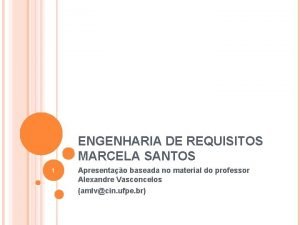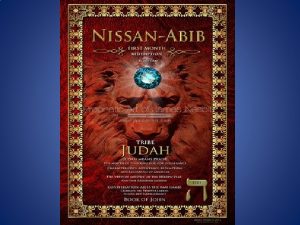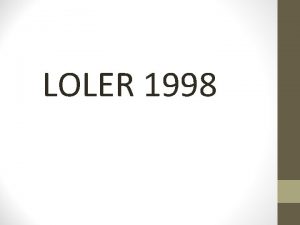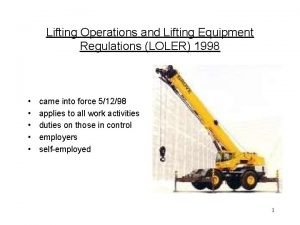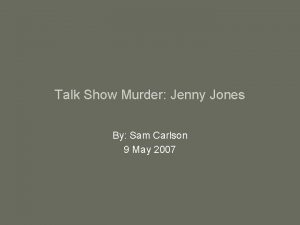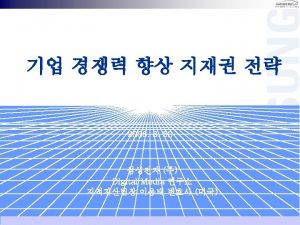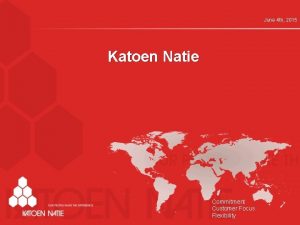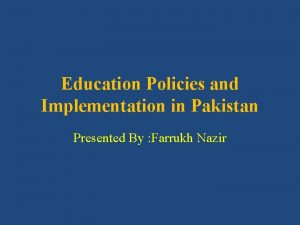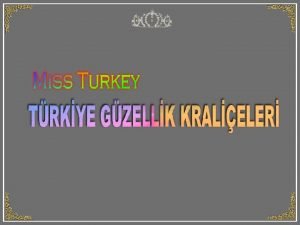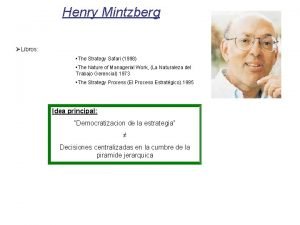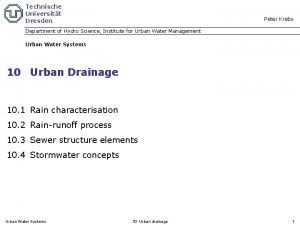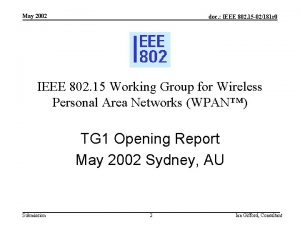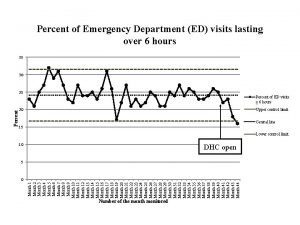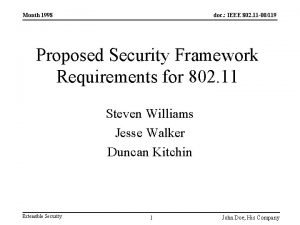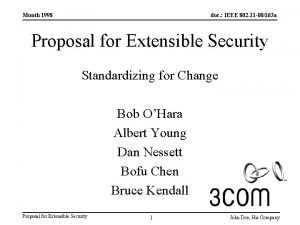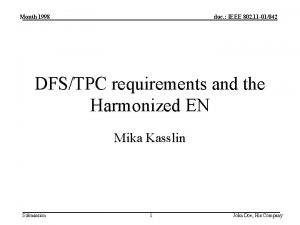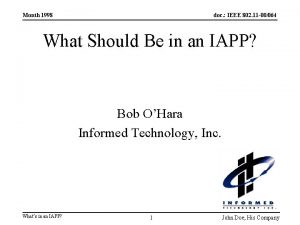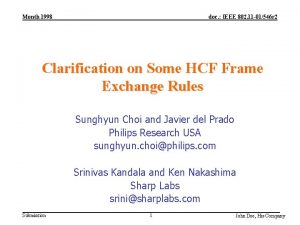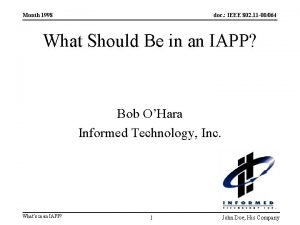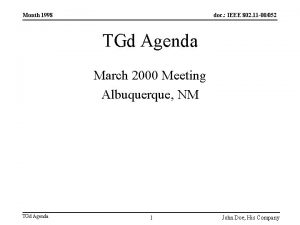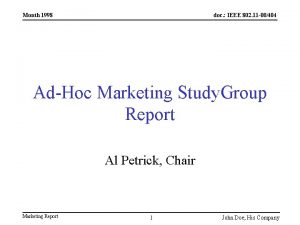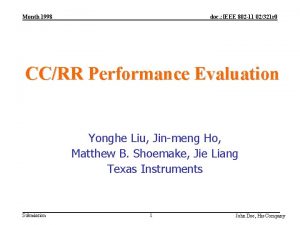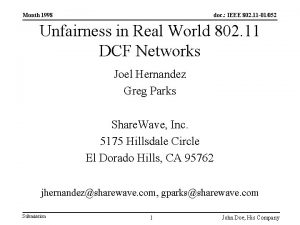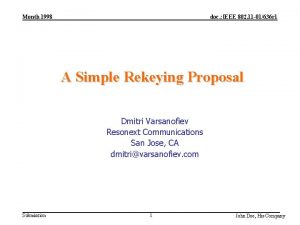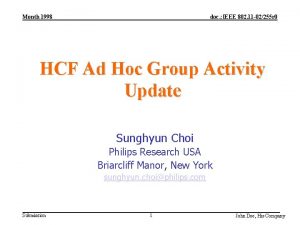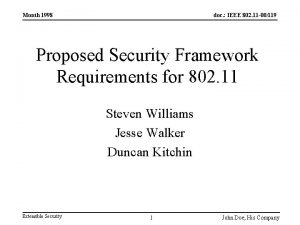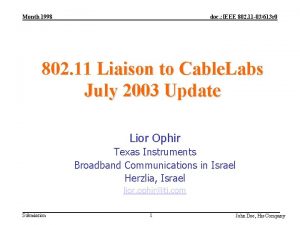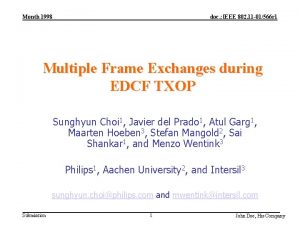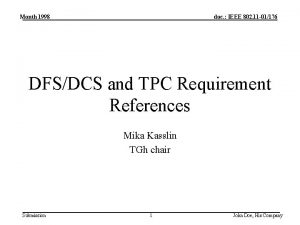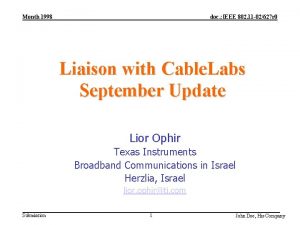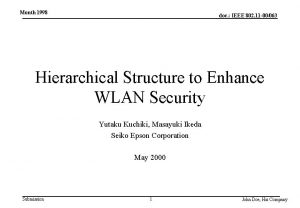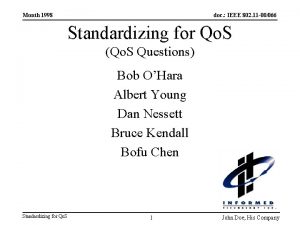Month 1998 doc IEEE 802 11 02181 r






























- Slides: 30

Month 1998 doc. : IEEE 802. 11 -02/181 r 1 802. 11 g Contention Period – Solution for Co-existence with Legacy Sunghyun Choi+, Olaf Hirsch*, Atul Garg*, Javier del Prado+ +Philips Research and *Philips Semiconductors Submission 1 John Doe, His Company

March 2002 doc. : IEEE 802. 11 -02/181 r 1 Outline • Background • Analysis of using RTS/CTS for. 11 g ERP • 802. 11 g CP – a simple but efficient solution for co-existence • Revision made simple! – need to add only a single sentence into the draft Submission 2 S. Choi, et al. , Philips

March 2002 doc. : IEEE 802. 11 -02/181 r 1 Assumptions • . 11 g and. 11 b STAs co-exist in a BSS. • BSS Basic Rate set is equal to or a subset of. 11 b DSSS/CCK rates. • Legacy. 11 b STAs may not correctly see a pure OFDM ERP frame as a busy channel. Submission 3 S. Choi, et al. , Philips

March 2002 doc. : IEEE 802. 11 -02/181 r 1 Background • 802. 11 g/D 2. 1 - Using CCK-RTS/CTS to make. 11 b STAs set NAV during pure OFDM frame transmissions – Legacy Indication information element newly defined for the purpose • 02/051 r 0 -. 11 g and. 11 b collision avoidance via OFDM CP – Needed to add a new information element in beacons & some MAC operation changes Submission 4 S. Choi, et al. , Philips

March 2002 doc. : IEEE 802. 11 -02/181 r 1 Comments on RTS/CTS • It is a plausible solution apparently! • But, this will lead to high overhead and reduce the maximum system throughput compared to the pure OFDM network. – See the next! • It turns out that fragmentation should not be used for MSDU transmitted at a pure OFDM ERP rate and protected by RTS/CTS. – See the next! • Have to minimize the usage of RTS/CTS !!! Submission 5 S. Choi, et al. , Philips

March 2002 doc. : IEEE 802. 11 -02/181 r 1 Analytical Comparison • . 11 g two RTS/CTS options considered: – Long RTS: 2 Mbps rate & Long preamble (more realistic? ) – Short RTS: 11 Mbps rate & Short preamble (as assumed in 02/065) • Theoretical throughput analysis – Assuming one transmitter and one receiver – See next … Submission 6 S. Choi, et al. , Philips

March 2002 doc. : IEEE 802. 11 -02/181 r 1 Transmission Time Comparison Preferred Choice Submission 7 S. Choi, et al. , Philips

March 2002 doc. : IEEE 802. 11 -02/181 r 1 Theoretical Throughput Comparison Preferred Choice Submission 8 S. Choi, et al. , Philips

March 2002 doc. : IEEE 802. 11 -02/181 r 1 . 11 g Fragmentation Problem • RTS/CTS protect only the first fragment and ACK. • The subsequent fragments are not protected! Submission 9 S. Choi, et al. , Philips

March 2002 doc. : IEEE 802. 11 -02/181 r 1 Complementary Solution • To reduce the usage of RTS/CTS … • 802. 11 g Contention Period (CP)! – Similar to OFDM CP of 02/051 r 0 … • . 11 g CP does not require any new information element!!! • Moreover, it can be achieved using a recommended practice as using CCK-RTS/CTS is according to 802. 11 g/D 2. 1. Submission 10 S. Choi, et al. , Philips

March 2002 doc. : IEEE 802. 11 -02/181 r 1 802. 11 MAC – CFP and CP • • Superframe = CFP and CP CFP starts with a beacon transmission PCF during CFP and DCF during CP (802. 11 e HCF during both CFP and CP) Submission 11 S. Choi, et al. , Philips

March 2002 doc. : IEEE 802. 11 -02/181 r 1 PCF Element and Frames • CF Parameter Set element • CF-END and CF-END + CF-Ack control frames – RA is broadcast group address Submission 12 S. Choi, et al. , Philips

March 2002 doc. : IEEE 802. 11 -02/181 r 1 PCF Operation during CFP • NAV is reset if CF-END (+ CF-ACK) is received • So, CFP ends with a CF-END (+ CF-ACK) Submission 13 S. Choi, et al. , Philips

March 2002 doc. : IEEE 802. 11 -02/181 r 1 . 11 g CP – Contention by. 11 g STAs Only! • . 11 g CP starts with a CF-END (+ CF-ACK) transmitted at an ERP rate Submission 14 S. Choi, et al. , Philips

March 2002 doc. : IEEE 802. 11 -02/181 r 1 During. 11 g CP … • . 11 g CP is part of CFP to. 11 b STAs!!! • So, . 11 g STAs do not need to use protection mechanisms (such as RTS/CTS and no fragmentation) during. 11 g CP • Is it true? Not really. See the next! Submission 15 S. Choi, et al. , Philips

March 2002 doc. : IEEE 802. 11 -02/181 r 1 Collision Example • The. 11 g ERP frame should have been protected with CCK-RTS/CTS! Submission 16 S. Choi, et al. , Philips

March 2002 doc. : IEEE 802. 11 -02/181 r 1 Solution • . 11 g STAs should start using protection mechanisms beginning T(. 11 b CP start) – T_extra, not beginning T(. 11 b CP start) Submission 17 S. Choi, et al. , Philips

March 2002 doc. : IEEE 802. 11 -02/181 r 1 Two Ways to Determine T_extra 1. T_extra = maximum transmission time of an MSDU at a. 11 g ERP rate – 4. 8 msec for 2304 octect MSDU transmitted at 6 Mbps with 11 fragments 2. T_extra = duration of a pending frame exchange sequence, which cannot be finished by the upcoming T(. 11 b CP start) – Should be smaller than 4. 8 msec – Can maximize. 11 g CP advantage at the cost of duration calculations! Submission 18 S. Choi, et al. , Philips

March 2002 doc. : IEEE 802. 11 -02/181 r 1 Why This Mechanism Works? • CF-Awareness is not optional !!! • According to 802. 11 -1999, 802. 11 STAs shall – Understand CF Parameter Set elements – Preset NAV at Target Beacon Transmission Time (TBTT) when a CFP is scheduled to start – See 9. 3. 2. 2 & Annex A. 4. 4. 1 PICS PC 3. 1 • Reception of CF-END (+ CF-ACK) shall be supported by 802. 11 STAs – See Annex A. 4. 4. 2 PICS FR 16 & RF 17 Submission 19 S. Choi, et al. , Philips

March 2002 doc. : IEEE 802. 11 -02/181 r 1 What AP Needs to Do? • Include CF Parameter Set information element even if no need for CFP – When CFP is not actually needed, a CF-END follows a beacon with a SIFS time gap (or PIFS time gap in case of 802. 11 e). • Transmit CF-END or CF-END+CF-ACK at one of ERP mandatory rates Submission 20 S. Choi, et al. , Philips

March 2002 doc. : IEEE 802. 11 -02/181 r 1 What. 11 g STA Needs to Do? • When Bit 1 of Legacy Indication element is set to one, protection mechanisms are used only during. 11 b CP and the last part of. 11 g CP. • The length of the last part of. 11 g to use protection mechanisms can be determined according to one of two ways explained earlier. Submission 21 S. Choi, et al. , Philips

March 2002 doc. : IEEE 802. 11 -02/181 r 1 Single Change from 802. 11 g/D 2. 1 • 802. 11 b Clause 9. 6 reads: “All frames with multicast and broadcast RA shall be transmitted at one of the rates included in the BSS basic rate set, regardless of their type or subtype. ” • Add the following the above sentence: “For the Extended Rate PHY, control frames of subtypes CF-END and CF-END + CF-ACK may be transmitted at one of the Extended Rate PHY (ERP) mandatory rates irrespective of the BSS basic rate set. ” Submission 22 S. Choi, et al. , Philips

March 2002 doc. : IEEE 802. 11 -02/181 r 1 Simulation Results Submission 23 S. Choi, et al. , Philips

March 2002 doc. : IEEE 802. 11 -02/181 r 1 OPNET Simulation Model • Revised our 11 b model • Supports 2 OFDM – 11 g modulations (24 and 6 Mbps) + 4 11 b modulations. • Slight change in the MAC model. Submission 24 S. Choi, et al. , Philips

March 2002 • • doc. : IEEE 802. 11 -02/181 r 1 Simulation Scenarios 8 stations : 4. 11 b and 4. 11 g Same load per STA – Network overloaded • 11 g stations: – Data + Ack at 24 Mbps – RTS/CTS transmitted using 11 b – 2 Mbps with long preamble • 11 b stations (long preamble): – Data at 11 Mbps – Control frames at 2 Mbps Submission 25 S. Choi, et al. , Philips

March 2002 doc. : IEEE 802. 11 -02/181 r 1 Simulation Scenarios 1) DCF: – – 11 g stations use RTS/CTS always Beacon interval = 100 ms 2) 11 g_CP_11 b_CP – – – – Submission Beacon interval = 100 ms. CFP_Max_Perido (in the beacon) = 50 ms Beacon transmitted at 2 Mbps CF-END transmitted right after the beacon at 24 Mbps so 11 b stations don’t receive it 11 g CP: only 11 g stations contend for the medium. RTS/CTS not used 11 b CP: both 11 g and 11 b stations contend for the medium. 11 g stations use RTS/CTS T_extra = 5 ms 26 S. Choi, et al. , Philips

March 2002 doc. : IEEE 802. 11 -02/181 r 1 Simulation Scenarios 3) 11 g_CP_11 b_CP_T_extra_adjusted: – Same scenario as (2). – The T_extra is adjusted according to the duration of each frame Simulations results in next slides are for a frame size of 1500 bytes Submission 27 S. Choi, et al. , Philips

March 2002 doc. : IEEE 802. 11 -02/181 r 1 Aggregated Throughput Submission 28 S. Choi, et al. , Philips

March 2002 doc. : IEEE 802. 11 -02/181 r 1 2 nd simulation: 11 b traffic starts at 30 seconds Note: Although there is no 11 b traffic, the 11 g stations keep using RTS/CTS (always in the first scenario, during the 11 b CP in the 2 last scenarios) Submission 29 S. Choi, et al. , Philips

March 2002 doc. : IEEE 802. 11 -02/181 r 1 Aggregate Throughput Submission 30 S. Choi, et al. , Philips
 Bridges from 802.x to 802.y
Bridges from 802.x to 802.y Bridges from 802.x to 802.y
Bridges from 802.x to 802.y Abreviação
Abreviação Ieee 829 standard
Ieee 829 standard Ieee/ansi 830-1998
Ieee/ansi 830-1998 Ieee 802 family
Ieee 802 family Ieee 802 3 compliance
Ieee 802 3 compliance Ieee802.22
Ieee802.22 Arquitetura ieee 802
Arquitetura ieee 802 El 802
El 802 Ieee 802 standard
Ieee 802 standard Bluetooth ieee 802
Bluetooth ieee 802 802 ieee
802 ieee Ieee 802
Ieee 802 Tribe of judah
Tribe of judah Sidereal month vs synodic month
Sidereal month vs synodic month Loler 1998
Loler 1998 Provision and use of work equipment regulations
Provision and use of work equipment regulations Loler 1998 legislation
Loler 1998 legislation Jenny jones killer episode
Jenny jones killer episode Sabah water resources enactment 1998
Sabah water resources enactment 1998 Wagner chronic care model 1998
Wagner chronic care model 1998 Dunbar 1998
Dunbar 1998 Modelo intelect (euroforum 1998)
Modelo intelect (euroforum 1998) Hampel report
Hampel report 1997-1998
1997-1998 Ktn kallo haven 1998
Ktn kallo haven 1998 National education policy 1998
National education policy 1998 1981 türkiye güzeli
1981 türkiye güzeli Escuela empresarial mintzberg
Escuela empresarial mintzberg Din 1998
Din 1998




